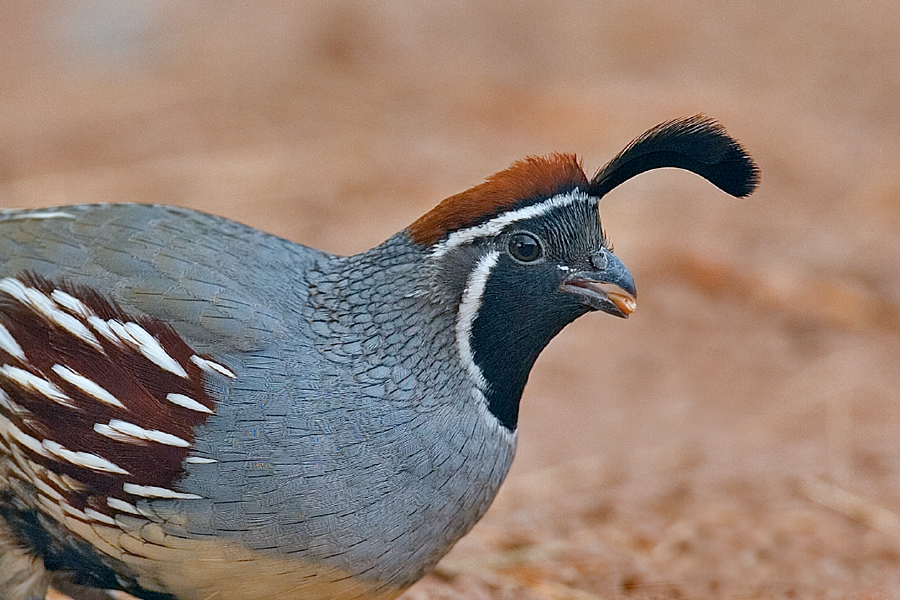- Gambel's Quail
Taxobox
name = Gambel's Quail
status = LC | status_system = IUCN3.1

image_width = 250px
image_caption = male

image2_width = 250px
image2_caption = female
regnum =Animal ia
phylum = Chordata
classis = Aves
ordo =Galliformes
familia = Odontophoridae
genus = "Callipepla "
species = "C. gambelii"
binomial = "Callipepla gambelii"
binomial_authority = Gambel, 1843The Gambel's Quail, "Callipepla gambelii", is a small ground-dwelling bird in the
New World quail family. It inhabits thedesert regions ofArizona ,California ,Colorado ,New Mexico ,Nevada ,Utah ,Texas , andSonora ; also New Mexico-borderChihuahua and theColorado River region ofBaja California . The Gambel's quail is named in honor ofWilliam Gambel , a 19th century naturalist andexplorer of theSouthwestern United States .These birds are easily recognized by their top knots and scaly plumage on their undersides. Gambel's quail have gray plumage on much of their bodies, and males have copper feathers on the top of their heads, black faces, and white stripes above their eyes. Gambel's quail can be commonly confused with
California Quail due to similar plumage. They can usually be distinguished by range, but when this does not suffice, California quail have a more scaly appearance and the black patch on the lower breast of the male Gambel's Quail is absent in the California Quail. The two species aresister taxa which diverged during the LatePliocene or EarlyPleistocene , 1 to 2 mya (Zink & Blackwell, 1998).The bird's average length is 11 inches (30 cm) with a
wingspan of 14-16 inches (35-40 cm). Its diet consists primarily of plant matter and seeds. Gambel's quail primarily move about by walking, and can move surprisingly fast through brush and undergrowth. They are a non-migratory species and are rarely seen in flight. Any flight is usually short and explosive, with many rapid wingbeats followed by a slow glide to the ground. These birds have relatively short, rounded wings and long, featherless legs.In the late summer, fall and winter, the adults and immature young congregate into coveys of many birds. In the spring, Gambel's quail pair off for mating and become very aggressive toward other pairs. The chicks are decidedly more
insectivorous than adults, gradually consuming more plant matter as they mature. Gambel's quail aremonogamous , and rarely breed in colonies. The female typically lays 10-15 eggs in a simple scrape concealed in vegetation, often at the base of a rock or tree. Incubation lasts from 21-24 days, usually performed by the female and rarely by the male. The chicks areprecocial , leaving the nest with their parents within hours of hatching.There is an annual hunt for this bird in some places. The hunting season usually lasts from October to February.
Gallery
References
* Database entry includes justification for why this species is of least concern
*ITIS|ID=175877|taxon=Callipepla gambelii|year=2006|date=9 February
* Thomson, M. (2001): [http://animaldiversity.ummz.umich.edu/site/accounts/information/Callipepla_gambelii.html Callipepla gambelii] . "In:
Animal Diversity Web ". Accessed September 26, 2006* Zink, Robert M. & Blackwell, Rachelle C. (1998): Molecular systematics of the Scaled Quail complex (genus "Callipepla"). "Auk" 115(2): 394-403. [http://elibrary.unm.edu/sora/Auk/v115n02/p0394-p0403.pdf PDF fulltext]
External links
* [http://tolweb.org/movies/Callipepla_gambelii/88677 Gambel's Quail videos] (Tree of Life)
* [http://ibc.hbw.com/ibc/phtml/especie.phtml?idEspecie=967 Gambel's Quail videos] on the Internet Bird Collection
* [http://www.sdakotabirds.com/species_photos/gambels_quail.htm Gambel's Quail Photographs] South Dakota Birds and Birding
* [http://www.bird-stamps.org/cspecies/3700800.htm Stamps] (forMexico ,United States ) with RangeMap
* [http://vireo.acnatsci.org/search.html?Form=Search&SEARCHBY=Common&KEYWORDS=gambel%27s+quail&showwhat=images&AGE=All&SEX=All&ACT=All&Search=Search&VIEW=All&ORIENTATION=All&RESULTS=24 Gambel's Quail photo gallery] VIREO: [http://vireo.acnatsci.org/search.html?mode=stored&offset=24 2nd] includes-egg clutch
Wikimedia Foundation. 2010.
